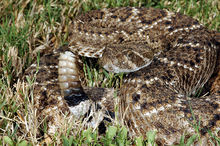With the on-going summer heat holding steady into fall, snakes are out of hiding and into areas where horses and people are enjoying days in the sun. If you live, ride or pasture your horse in an area prone to rattlesnakes, it is important that you consider having your horse vaccinated in case it is bitten by a rattlesnake.

A well-camouflaged rattle snake
Clinical signs of snake bites in horses are the result of local effects of the venom which is highly complex and toxic properties vary among snake species and between individuals within the same species.
Because of the inquisitive nature of horses, bites usually occur on the muzzle and head of the horse, but bites can also occur on the limbs or other parts of the body.
An acute onset of swelling and edema at the bite site are often the first clues that a horse has been bitten. The muzzle and nasal passages may become swollen to the extent that respiration is extremely labored. Death from snake bite is rare in horses, but the horse can be very uncomfortable for quite some time following a snake bite.
The clinical signs associated with snake bites are usually the result of the local effects of the venom. Snake venom is a highly complex mixture and the composition and toxic properties vary among snake species and between individuals within the same species.
Owners who witness a snake bite should consider it a true emergency. Keep the horse quiet and calm, and call the veterinarian or transport the horse as quickly as possible to a referral hospital.
If the horse is found with a swollen muzzle and nasal passages and is struggling to breathe, short pieces of garden hose--about 10-inches long--can be passed into the nasal passages to maintain breathing. This is essential, since horses are obligate nose-breathers, meaning they only breathe through their noses, not through their mouths.
According to AAEP, pre-exposure vaccination may be recommended for horses in geographic areas or for those traveling to areas where exposure to venomous snakes justifies vaccine usage.
A conditionally licensed inactivated (Crotalus atrox Toxoid) vaccine for use in healthy horses 6 months of age or older is available as an aid in the reduction of morbidity and mortality due to intoxication with Crotalus atrox toxin.
The label claim for the vaccine is that it may also provide protection against the venoms of the Western Rattlesnake (including the Prairie, Great Basin, Northern and Southern Pacific varieties), Sidewinder, Timber Rattlesnake, Massasauga and the Copperhead. Partial protection may be obtained against Eastern Diamondback Rattlesnake venom. This vaccine does not provide protection against venom from the Water Moccasin (Cottonmouth), Mojave Rattlesnake or Coral Snake.
The administration of anti-inflammatory drugs (phenylbutazone or banamine) can help minimize swelling during the early stages The treatment for a horse that was bitten by a rattlesnake depends on the location of the bite and the severity of the clinical signs.
Tracheotomy is indicated in horses that develop excessive edema and swelling of the head and external nares (nose) to the point that respiration becomes impaired. Additional treatment includes the administration of tetanus prophylaxis, systemic antibiotics, and an anti-inflammatory.
Animals affected with systemic hypotension (decreased or low blood pressure) or who are unable to eat/drink will benefit from intravenous fluid therapy.
The best prevention of snake bites is to avoid areas infested with rattlesnakes and be aware of the times snakes are most likely to be on trails and in places your horse may be grazing.
